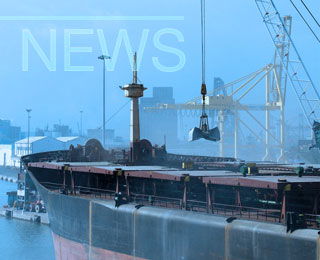At Cemtech's live webinar on the 'seaborne trade of cement and clinker' this week, Ad Ligthart of Cement Distribution Consultants, gave a sobering outlook on global trade in response to COVID-19 and the many government lockdowns that have been implemented worldwide.
"Seaborne trade of cement and clinker will be seriously affected," said Mr Ligthart, adding: "There will be a global reduction in cement consumption and the result of that for seaborne trade and distribution is that the drop will be a lot larger than that.
"Cement consumption will fall significantly this year, probably next year will be even worse," argued Mr Ligthart. "The whole economy will be simply down for a longer period and cement consumption will go with it. It could be years before we get back to the levels of trade in 2019."
2019 snapshot
It's estimated that the total volume of global seaborne trade amounted to 283Mt in 2019. Of this, cement and clinker accounted for 135Mt, seaborne distribution 110Mt and cementitious materials 38Mt. Trade in clement and clinker trade improves the utilisation rates of many cement plants, raising profitability and contributing around US$4-5bn to the margins of the plants involved.
Global fall in cement consumption – who will be impacted the most?
There is no clear figure at the moment regarding the extent of the collapse in demand as the situation is still evolving. All we know is that the trend will be downwards.
"It is difficult to say how much global cement will go down. The financial models are not made for pandemics," said Mr Ligthart. "It could take more than a year to find a vaccine, and if it takes two years or more, this is expected to have a huge impact on the global economy.
"Different types of economies will react differently. Anglo-Saxon economies [predominantly English-speaking countries] have far more boom and bust cycles for example than within the European Union (EU)," said Mr Ligthart. "However, in the EU recovery is usually slower as well."
In addition, with cement consumption contracting globally, we will see governments protecting their industries against uncontrolled imports.
The markets where trade will suffer most can be identified. Seaborne trade to countries with their own industry with a structural shortage, such as the USA and UK, will see big changes. In fact, Ad Ligthart confirmed that, "here the situation will change the most."
If cement consumption falls in these markets, local producers will seek to reduce imports to keep their cement plants running at the highest possible utilisation rate and uncontrolled imports will have anti-dumping suits to contend with. "In these countries the producers also control most of the imports so they themselves will reduce imports," added Mr Ligthart. "This can lead to tremendous swings in the imports."
If the USA sees a 10 per cent drop in cement consumption, we could see a 7.5Mt drop off in cement and clinker seaborne trade to the USA. "That is quite serious for the European and Turkish exporters," said Mr Ligthart. US imports in 2019 received 7.7Mt of cement from Europe (mainly Turkey) and 2.37Mt from Asia. "These numbers could fall to as low as 2.5Mt in 2020, of which 0.8Mt will be made up of white cement," said Mr Ligthart. This is likely to see many cement terminals being mothballed, along with coastal grinding plants.
In Europe and the US we can expect large infrastructure spending to support the economies, but this is expected to come with demands for lower CO2 footprints. Europe has already been combining its infrastructure spending with its 'Green Agenda'. The EU-ETS trading scheme will likely come under scrutiny if the fall in cement consumption exceeds 20 per cent, as the industry will receive more free CO2 allowances than it actually produces. Under these circumstances the carbon border mechanism proposed by Cembureau to place a tariff on non-EU imports looks unrealistic.
Outlook and regional differences
Seaborne trade of cement and clinker will see a significantly larger fall than the global fall in cement consumption. This is due to keeping integrated plants in import countries operating at highest-possible utilisation levels and anti-dumping protectionism to prevent uncontrolled imports.
However, Mr Ligthart concluded that while global cement demand will drop significantly this year, it could decline much further next year. "Regional differences will be very large," he added. "There will be a rapid drop of trade to Anglo-Saxon communities. 2H20 consumption may return but in terms of large infrastructure projects it may take one-and-a-half years to pick up. The EU's recovery could be less pronounced but the market may take longer. Chinese consumption will fall further and faster. Africa may suffer less than expected as it has strong growth potential. Southeast Asia will probably see a number of uncertain years.
"
On a positive note, white cement and cementitious materials will be less affected and will recover quickest.
"Without doubt what we see with crisis is a lot of change and that will happen in the cement industry and seaborne trade of cement and clinker," said Mr Ligthart. "A number of coastal grinding plants and terminals are likely to be mothballed, while mergers and acquisitions are likely to accelerate."
Join the next Cemtech Live Webinar on 20 May exploring the digital transformation of the cement industry. Register here
